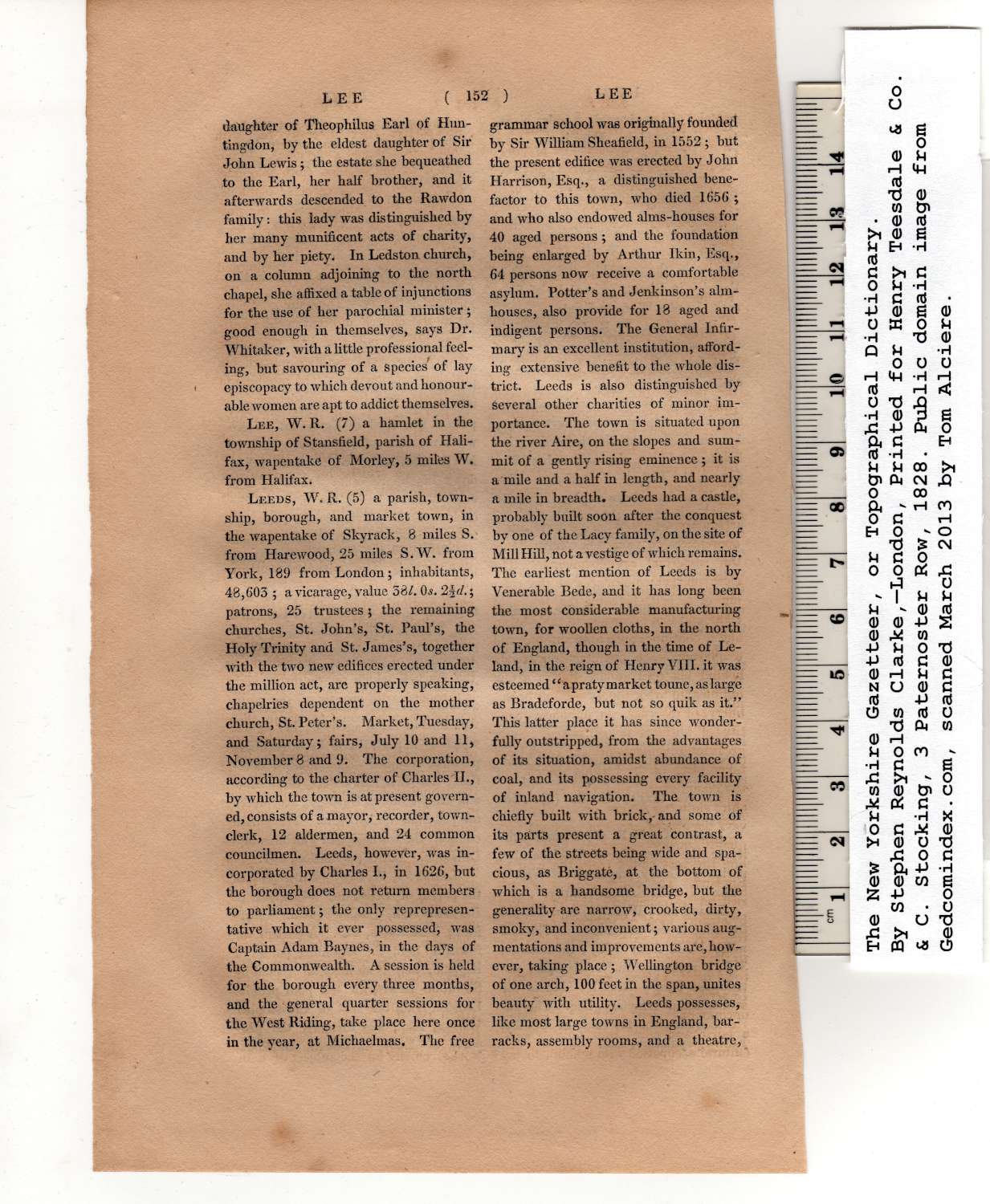|
daughter of Theophilus Earl of Hun-
tingdon, by the eldest daughter of Sir
John Lewis; the estate she bequeathed
to the Earl, her half brother, and it
afterwards descended to the Rawdon
family: this lady was distinguished by
her many munificent acts of charity,
and by her piety. In Ledston church,
on a column adjoining to the north
chapel, she affixed a table of injunctions
for the use of her parochial minister;
good enough in themselves, says Dr.
Whitaker, with a little professional feel-
ing, but savouring of a species of lay
episcopacy to which devout and honour-
able women are apt to addict themselves.
Lee, W.R. (7) a hamlet in the
township of Stansfield, parish of Hali-
fax, wapentake of Morley, 5 miles W.
from Halifax. |
Leeds, W. R. (5) a parish, town-
ship, borough, and market town, in
the wapentake of Skyrack, 8 miles S.
from Harewood, 25 miles S.W. from
York, 189 from London; inhabitants,
48,605 ; a vicarage, value 38/. Os. 2§t/.;
patrons, 25 trustees; the remaining
churches, St. John’s, St. Paul’s, the
Holy Trinity and St. James’s, together
with the two new edifices erected under
the million act, are properly speaking,
chapelries dependent on the mother
church, St. Peter’s. Market, Tuesday,
and Saturday; fairs, July 10 and 11,
November 8 and 9. The corporation,
according to the charter of Charles II.,
by which the town is at present govern-
ed, consists of a mayor, recorder, town-
clerk, 12 aldermen, and 24 common
councilmen. Leeds, however, was in-
corporated by Charles I., in 1626, but
the borough does not return members
to parliament; the only reprepresen-
tative which it ever possessed, was
Captain Adam Baynes, in the days of
the Commonwealth. A session is held
for the borough every three months,
and the general quarter sessions for
the West Riding, take place here once
in the year, at Michaelmas. The free
grammar school was originally founded
by Sir William Sheafield, in 1552; but
the present edifice was erected by John
Harrison, Esq., a distinguished bene-
factor to this town, who died 1656 ;
and who also endowed alms-houses for
40 aged persons; and the foundation
being enlarged by Arthur Ikin, Esq.,
64 persons now receive a comfortable
asylum. Potter’s and Jenkinson’s alm-
houses, also provide for 18 aged and
indigent persons. The General Infir-
mary is an excellent institution, afford-
ing extensive benefit to the whole dis-
trict. Leeds is also distinguished by
Several other charities of minor im-
portance. The town is situated upon
the river Aire, on the slopes and sum-
mit of a gently rising eminence; it is
a mile and a half in length, and nearly
a mile in breadth. Leeds had a castle,
probably built soon after the conquest
by one of the Lacy family, on the site of
Mill Hill, not a vestige of which remains.
The earliest mention of Leeds is by
Venerable Bede, and it has long been
the most considerable manufacturing
town, for woollen cloths, in the north
of England, though in the time of Le-
land, in the reign of Henry VIII. it was
esteemed “ apraty market toune, as large
as Bradeforde, but not so quik as it.”
This latter place it has since wonder-
fully outstripped, from the advantages
of its situation, amidst abundance of
coal, and its possessing every facility
of inland navigation. The town is
chiefly built with brick, and some of
its parts present a great contrast, a
few of the streets being wide and spa-
cious, as Briggate, at the bottom of
which is a handsome bridge, hut the
generality are narrow, crooked, dirty,
smoky, and inconvenient; various aug-
mentations and improvements are, how-
ever, taking place; Wellington bridge
of one arch, 100 feet in the span, unites
beauty with utility. Leeds possesses,
like most large towns in England, bar-
racks, assembly rooms, and a theatre, |
